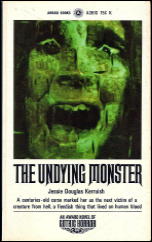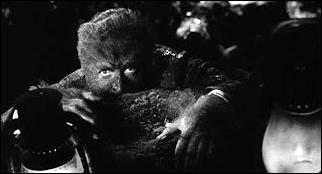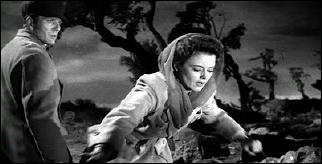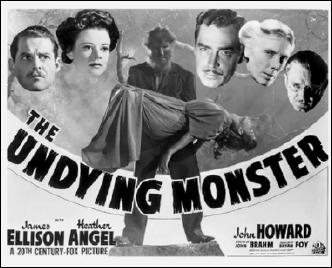Tue 5 Feb 2013
Reviewed by Dan Stumpf (Book/Film): THE UNDYING MONSTER (1922/1942)
Posted by Steve under Horror movies , Reviews[6] Comments
JESSIE DOUGLAS KERRUISH – The Undying Monster. Heath Cranton, UK, hardcover, 1922. Macmillan, US, hardcover, 1936. Reprinted in Famous Fantastic Mysteries, June 1946. Award A351S, paperback, 1968. Lulu Press, POD softcover, 2013.

THE UNDYING MONSTER. 20th Century Fox, 1942. James Ellison, Heather Angel, John Howard, Bramwell Fletcher, Heather Thatcher, Aubrey Mather. Director: John Brahm.
The Undying Monster by Jessie Douglas Kerruish was first published in England in 1922 and is considered by some a classic tale of lycanthropy. I considered it a wanton squandering of my precious youth, but there you are. Thinking back, there were probably some inventive bits in the tale, but for me they were ruined by…. But I can’t yet tell you why. Read on:
Undying starts out promisingly with a family curse, murder in the moonlight and all sorts of delicious Victorian nastiness. It seems that the Hammand family (local gentry with an imposing manor house and a coat of arms that goes back to the Flood) is periodically stalked from time to time by a horrendous but unseen thing that rips some of them limb from limb and scares others into gibbering madness.
Good so far. But when Oliver Hammand, latest in line to inherit the family unpleasantness, encounters the thing in the dark, he gets off with a few bites and a case of amnesia while his companion is mauled to near death and his loyal dog is spread all over the countryside. Naturally concerned, Oliver’s sister calls in female paranormal investigator Luna Bartendale, and that’s when things get gummy.

Luna Bartendale is probably the most irritating character ever consigned to printed page. She hasn’t been on the case for more than a few paragraphs before she’s saying things like, “I have some theories but I won’t discuss them until….†and then “This confirms what I was thinking but before I say more I must…..†followed by “I know why, but I can’t reveal it to you yet,†and “There’s a very good reason why I can’t tell it to you.â€
Now I got nothing, against foreshadowing, but a man gets tired of that kind of talk all the time. No one likes the guy who says “I told you so,†but even worse is one who says “I could tell you so — if I felt like it,†and Luna Bartendale, for all her groundbreaking appearance as fiction’s first female paranormal detective, says very little else. By the time the plot reached the point where Good and Evil were locked in what should have been a horrific struggle, I was hoping merely that the superannuated boogeyman of the title would gobble her up but (SPOILER ALERT!) no such luck.
All the sadder then that there are glimmerings of a good story here. So good in fact that 20th Century Fox made a movie of it in 1942 — kind of. Writer Lillie Hayward and Michael Jacoby replaced the annoying Ms Bartendale with cowboy star James Ellison playing a Scotland Yard investigator — and doing it surprisingly well.

He’s aided by Heather Thatcher as a plucky distaff-Watson, but his attentions are focused primarily on Heather Angel as the distraught sister of poor Oliver Hammond (They changed the spelling for reasons best known to themselves.) played by John Howard, who had already been paired with Miss Angel in the Bulldog Drummond series over at Paramount.
Undying Monster is a stylish affair, thanks largely to director John Brahm, who brought similar gothic elegance to The Lodger (1944) and Hangover Square (1945) and cinematographer Lucien Ballard, who will be remembered for The Wild Bunch. Together they impart an atmosphere not unlike the Sherlock Holmes series over at Universal, with evocative fog, looming shadows, and a general sense of mystery — rudely dissipated when we finally see the rather unprepossessing monster.
And I should add a bit of trivia beloved of bad-movie buffs: the opening shot of Undying Monster is repeated exactly in a later, cheaper Monogram film, Face of Marble (1946). Understandable, since Michael Jacoby, who toiled at or near Hollywood’s bottom rung for his whole career, worked on both films. But one wonders with what weary desperation poor Jacoby found himself re-typing his own work in such reduced circumstances.

February 5th, 2013 at 12:04 pm
A MUST read and MUST see, without any doubt .
The Doc
February 5th, 2013 at 5:49 pm
I prefer the book over the movie. I wasn’t bothered by Luna’s withholding of information; it’s all part of the genre, particularly of its time. The movie though stylish and stunning with its settings and moodily lit scenes lacks any of the really interesting aspects that would’ve made it a cut above the average werewolf movie. Gone are the references to Norse mythology, the fantastic scene in the crypt with the Hand of Glory (the best set piece in the book I’d say) and other bits of true detective work on Luna’s part.
February 5th, 2013 at 7:26 pm
Good deal. I’ve always had a soft spot for James Ellison.
February 5th, 2013 at 10:17 pm
Somewhat expensive for someone like me who just wants a reading copy.
However it’s available on Kindle for only $1.99. So that’s what I’ve just ordered.
February 6th, 2013 at 6:40 am
Todd Downing reviewed this book in the 1930s (the review is in my Clues and Corpses: The Detective Fiction and Mystery Criticism of Todd Downing, co-dedicated, incidentally, to Steve Lewis and with quite a few citations to Mystery*File and bloggers like John).
He didn’t like Luna either and was down on the whole love interest aspect.
Agree with the assessmnet of the film.
February 8th, 2013 at 4:59 pm
I must say that I have much fonder membories of the novel than Dan, but it’s been some years since I’ve read it and I’m not inclined to have another go at it just now.
I do remember seeing the film but, unless I’m misremembering the event, I recall that it went into general release later than 1942. I did see it in a fust-run theater (the Capitol) in Little Rock and was quite taken with it. When I saw it again, eons later, in its DVD release I was somewhat disappointed, with the ending exposing some of the most dismal makeup for a horror icon (the werewolf) I can recall.
I wasn’t surprised by James Ellison’s performance. I wasn’t aware of his history of performances in Western films, except for the one in DeMille’s “The Plainsman.” The other film I recall seeing him in was “I Walked With a Zombie,” one of my two favorites of the Lewton series. There he gave a polished performance that had no hint of a B-film history about it.
I have copies of both the British and American first editions, as well as the reprint in FFM, a favorite pulp and one of the few of which I have a complete run. Ash-Tree Press reprinted the novel in 2006, and can be recommended for the lengthy introduction by Jack Adrian on Kerruish and her career.